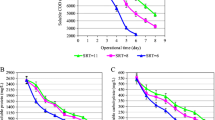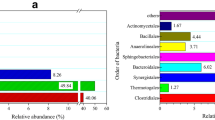Abstract
Three acid-producing strains, AFB-1, AFB-2 and AFB-3, were isolated during this study, and their roles in anaerobic digestion of waste activated sludge (WAS) were evaluated. Data of 16S rRNA method showed that AFB-1 and AFB-2 were Bacillus coagulans, and AFB-3 was Escherichia coli. The removal in terms of volatile solids (VS) and total chemical oxygen demand (TCOD) was maximized at 42.7% and 44.7% by inoculating Bacillus coagulans AFB-1. Besides, the optimal inoculum concentration of Bacillus coagulans AFB-1 was 30% (v/v). Solubilization degree experiments indicated that solubilization ratios (SR) of WAS reached 20.8%±2.2%, 17.7%±1.48%, and 11.1%±1.53%. Volatile fatty acids (VFAs) concentrations and compositions were also explored with a gas chromatograph. The results showed that VFAs improved by 98.5%, 53.0% and 11.6% than those of the control, respectively. Biochemical methane potential (BMP) experiments revealed that biogas production increased by 90.7% and 75.3% when inoculating with Bacillus coagulans AFB-1 and AFB-2. These results confirmed that the isolated acid-producing bacteria, especially Bacillus coagulans, was a good candidate for anaerobic digestion of WAS.

Similar content being viewed by others
References
American Public Health Association (APHA) (2005). Standard Method for the Examination of Water and Wastewater. 21st ed. Washington, DC: American Public Health Association
Babel S, Fukushi K, Sitanrassamee B (2004). Effect of acid speciation on solid waste liquefaction in an anaerobic acid digester. Water Research, 38(9): 2416–2422
Bohn J, Yüksel-Dadak A, Dröge S, König H (2017). Isolation of lactic acid-forming bacteria from biogas plants. Journal of Biotechnology, 244: 4–15
Cheng Y, He H, Yang C, Zeng G, Li X, Chen H, Yu G (2016). Challenges and solutions for biofiltration of hydrophobic volatile organic compounds. Biotechnology Advances, 34(6): 1091–1102
Cibis K G, Gneipel A, König H (2016). Isolation of acetic, propionic and butyric acid-forming bacteria from biogas plants. Journal of Biotechnology, 220: 51–63
Dearman B, Bentham R H (2007). Anaerobic digestion of food waste: Comparing leachate exchange rates in sequential batch systems digesting food waste and biosolids. Waste Management, 27(12): 1792–1799
Ding H H, Chang S, Liu Y (2017). Biological hydrolysis pretreatment on secondary sludge: Enhancement of anaerobic digestion and mechanism study. Bioresource Technology, 244(Pt 1): 989–995
Dwyer J, Starrenburg D, Tait S, Barr K, Batstone D J, Lant P (2008). Decreasing activated sludge thermal hydrolysis temperature reduces product colour, without decreasing degradability. Water Research, 42 (18): 4699–4709
Feng L, Chen Y, Zheng X (2009). Enhancement of waste activated sludge protein conversion and volatile fatty acids accumulation during waste activated sludge anaerobic fermentation by carbohydrate substrate addition: the effect of pH. Environmental Science & Technology, 43(12): 4373–4380
Feng L, Luo J, Chen Y (2015). Dilemma of sewage sludge treatment and disposal in China. Environmental Science & Technology, 49(8): 4781–4782
Guo J, Yang C, Zeng G (2013). Treatment of swine wastewater using chemically modified zeolite and bioflocculant from activated sludge. Bioresource Technology, 143: 289–297
He H J, Xiang Z H, Chen X J, Chen H, Huang H, Wen M, Yang C P (2017). Biosorption of Cd (II) from synthetic wastewater using dry biofilms from biotrickling filters. International Journal of Environmental Science & Technology, DOI: 10.1007/s13762-017-1507-8
Hwang M H, Jang N J, Hyun S H, Kim I S (2004). Anaerobic biohydrogen production from ethanol fermentation: The role of pH. Journal of Biotechnology, 111(3): 297–309
Jiang J, Zhang Y, Li K, Wang Q, Gong C, Li M (2013). Volatile fatty acids production from food waste: effects of pH, temperature, and organic loading rate. Bioresource Technology, 143: 525–530
Kavitha S, Preethi J, Rajesh Banu J, Yeom I T (2017). Low temperature thermochemical mediated energy and economically efficient biological disintegration of sludge: simulation and prediction studies for anaerobic biodegradation. Chemical Engineering Journal, 317: 481–492
Kavitha S, Yukesh Kannah R, Yeom I T, Do K U, Banu J R (2015). Combined thermo-chemo-sonic disintegration of waste activated sludge for biogas production. Bioresource Technology, 197: 383–392
Kepp U, Machenbach I, Weisz N, Solheim O E (2000). Enhanced stabilisation of sewage sludge through thermal hydrolysis—Three years of experience with full scale plant. Water Science & Technology, 42(9): 89–96
Kuglarz M, Karakashev D, Angelidaki I (2013). Microwave and thermal pretreatment as methods for increasing the biogas potential of secondary sludge from municipal wastewater treatment plants. Bioresource Technology, 134(2): 290–297
Li X, Yang W L, He H, Wu S, Zhou Q, Yang C, Zeng G, Luo L, Lou W (2018). Responses of microalgae Coelastrella sp. to stress of cupric ions in treatment of anaerobically digested swine wastewater. Bioresource Technology, 251: 274–279
Liu X L, Liu H, Du G C, Chen J (2009). Improved bioconversion of volatile fatty acids from waste activated sludge by pretreatment. Water Environment Research A Research Publication of the Water Environment Federation, 81(1): 13–20
Lizama A C, Figueiras C C, Herrera R R, Pedreguera A Z, Ruiz Espinoza J E (2017). Effects of ultrasonic pretreatment on the solubilization and kinetic study of biogas production from anaerobic digestion of waste activated sludge. International Biodeterioration & Biodegradation, 123: 1–9
Lv Y T, Chen X, Wang L, Ju K, Chen X Q, Miao R, Wang X D (2016). Microprofiles of activated sludge aggregates using microelectrodes in completely autotrophic nitrogen removal over nitrite (CANON) reactor. Frontiers of Environmental Science & Engineering, 10(2): 390–398
Peng L, Yang C, Zeng G, Wang L, Dai C, Long Z, Liu H, Zhong Y (2014). Characterization and application of bioflocculant prepared by Rhodococcus erythropolis using sludge and livestock wastewater as cheap culture media. Applied Microbiology and Biotechnology, 98 (15): 6847–6858
Qiao W, Yan X Y, Ye J H, Sun Y F, Wang W, Zhang Z Z (2011). Evaluation of biogas production from different biomass wastes with/without hydrothermal pretreatment. Renewable Energy, 36(12): 3313–3318
Schlüter A, Bekel T, Diaz N N, Dondrup M, Eichenlaub R, Gartemann K H, Krahn I, Krause L, Krömeke H, Kruse O, Mussgnug J H, Neuweger H, Niehaus K, Pühler A, Runte K J, Szczepanowski R, Tauch A, Tilker A, Viehöver P, Goesmann A (2008). The metagenome of a biogas-producing microbial community of a production-scale biogas plant fermenter analysed by the 454-pyrosequencing technology. Journal of Biotechnology, 136(1–2): 77–90
Sharma K K, Sharma S, Karp M, Kuhad R C (2012). Ligninolytic enzymes improve soil DNA purity: Solution to methodological challenges of soil metagenomics. Journal of Molecular Catalysis, B Enzymatic, 83(5): 73–79
Ushani U, Rajesh Banu J, Kavitha S, Kaliappan S, Yeom I T (2017). Immobilized and MgSO4 induced cost effective bacterial disintegration of waste activated sludge for effective anaerobic digestion. Chemosphere, 175: 66–75
Viéitez E R, Ghosh S (1999). Biogasification of solid wastes by twophase anaerobic fermentation. Biomass & Bioenergy, 16(5): 299–309
Wu S H, Shen Z Q, Yang C P, Zhou Y X, Li X, Zeng G M, Ai S J, He H J (2017). Effects of C/N ratio and bulking agent on speciation of Zn and Cu and enzymatic activity during pig manure composting. International Biodeterioration & Biodegradation, 119: 429–436
Yan S T, Miyanaga K, Xing X H, Tanji T (2008). Succession of bacterial community and enzymatic activities of activated sludge by heat-treatment for reduction of excess sludge. Biochemical Engineering Journal, 39(3): 598–603
Yang C, Chen H, Zeng G, Yu G, Luo S (2010a). Biomass accumulation and control strategies in gas biofiltration. Biotechnology Advances, 28(4): 531–540
Yang C, Wang J, Lei M, Xie G, Zeng G, Luo S (2010b). Biosorption of zinc(II) from aqueous solution by dried activated sludge. Journal of Environmental Sciences-China, 22(5): 675–680
Yang Y F, Zhang Y B, Li Z Y, Zhao Z Q, Quan X, Zhao Z S (2017). Adding granular activated carbon into anaerobic sludge digestion to promote methane production and sludge decomposition. Journal of Cleaner Production, 149: 1101–1108
Yu R, Zhang S W, Chen Z K, Li, C Y (2017a). Isolation and application of predatory Bdellovibrio-and-like organisms for municipal waste sludge biolysis and dewaterability enhancement. Frontiers of Environmental Science & Engineering, 11(1): 10
Yu T, Deng Y H, Liu H Y, Yang C P, Wu B W, Zeng G M, Lu L, Nishimura F (2017b). Effect of alkaline microwaving pretreatment on anaerobic digestion and biogas production of swine manure. Scientific Reports, 7(1): 1668 (1–8)
Zhang L L, He X, Zhang Z X, Cang D Q, Nwe K A, Zheng L, Li Z F, Cheng S K (2017). Evaluating the influences of Zno engineering nanomaterials on VFA accumulation in sludge anaerobic digestion. Biochemical Engineering Journal, 125: 206–211
Zhou Q, Lin Y, Li X, Yang C, Han Z, Zeng G, Lu L, He S (2018). Effect of zinc ions on nutrient removal and growth of Lemna aequinoctialis from anaerobically digested swine wastewater. Bioresource Technology, 249: 457–463
Acknowledgements
This work was supported by the Department of Education of Hunan Province (No. [2015] 801210003), the International S&T Cooperation Program of China (Project Contract No. 2015DFG92750), and the National Natural Science Foundation of China (Grant Nos. 51278464 and 51478172).
Author information
Authors and Affiliations
Corresponding authors
Rights and permissions
About this article
Cite this article
Ai, S., Liu, H., Wu, M. et al. Roles of acid-producing bacteria in anaerobic digestion of waste activated sludge. Front. Environ. Sci. Eng. 12, 3 (2018). https://doi.org/10.1007/s11783-018-1050-y
Received:
Revised:
Accepted:
Published:
DOI: https://doi.org/10.1007/s11783-018-1050-y




